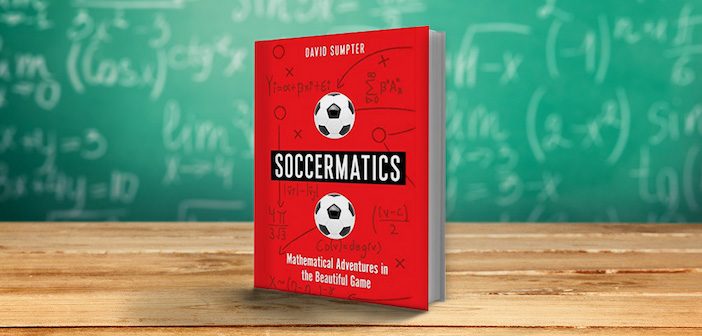IN the first of a new series, professional sports bettor, Neel Shah (@MyBettorLife), reviews some of the very best books out there that can raise your betting to the next level. This week, he looks at Professor David Sumpter’s fascinating book: Soccermatics.
Soccermatics: Mathematical Adventures in the Beautiful Game
The 21st century football fan is a different beast to years gone by. Watching pre or post match football coverage, you can’t help but be bombarded with stats on individual players and teams.
How many kilometres did they run? How much possession did team A have? How many calories were in the United goalkeeper’s breakfast this morning? Ok, maybe not the last one but you get the point. This sea change in sports science having a public face is a relatively recent phenomenon but this work has been going on behind the scenes for years.
Professor David Sumpter’s book, although published in 2016, is still relevant today. He looks at how data is used in the modern game and uses his own mathematical knowledge to see if he can beat the bookies. He’s an engaging author and although the book has maths in the title, you definitely don’t need to be a maths expert to understand it or enjoy it.
For context, I was a mediocre maths student at GCSE level and the formulas he uses are very clearly explained and simple to follow.
The book starts with some thoughts on the randomness of football and how you might build a simple mathematical model to predict football games using something called Poisson distribution. Of course, there are limitations to this method but it’s useful to understand as this kind of process is where many bookmakers start from when building their own betting lines.
The book detours slightly with a wonderful comparison of how slime moulds are like the 2010 Barcelona side (yes you did read that correctly) and a detailed analysis of team shape and the geometry of team set ups. All very interesting, but how is this relevant to your betting, you ask?
Pirlo and passing links
When reading this section, It certainly got me thinking about how this knowledge could be applied to more niche betting markets. For example, the role of Andrea Pirlo was compared both with Italy and Juventus at the time and how passing links were formed with his team mates.
Often, when looking at bets like player performances (such as at spread betting firms) or player passes bets, we look at a player in isolation. These kind of niche bets are often just priced on averages across a season and won’t necessarily factor in the opposition beyond their league table position.
Some teams in the bottom half like to keep the ball and some are happy to counter. Knowing how a player likes to spread their passes (are they mostly in their own half or is there forward momentum?) is a useful piece of knowledge to find some value opportunities.
We also don’t (and perhaps the bookies don’t) always factor in the effect on other secondary players. This season is a good example. At the time of writing, Harry Kane is out of the Tottenham team and of course this will have a knock on effect on their goal threat. However, more importantly than his goal threat, his absence to the team has caused Tottenham’s passing links to be fairly disjointed.
Something that might have been missed by the betting markets is their difficulties in keeping hold of the ball and their hold up play. One of the findings in the book was that teams who focus their passing on only a few players score fewer goals than teams that spread the ball around more evenly.
Teams passing at least 5 times a minute scored around 20% more goals in a season than those passing only 3 times a minute. Again, these might be subtle changes to look at but when a team might change manager and therefore tactics, this might have an effect that takes a while to develop and you may have a window of opportunity before the betting markets catch up.
Data-led approach
A wealth of other information is contained in this chapter and some of this data, although aimed at scouts and coaches, would definitely be useful to professional sports bettors and syndicates. Clubs are reluctant to release a lot of this data for understandable reasons but Professor Sumpter is of the belief that the field of football analytics is still emerging and the revolution is still in its infancy.
We all know how difficult it is to beat the bookmakers and betting markets long term, but having access to data like this and being able to apply it practically is one way to get a potential edge over the market that is still lagging behind in using this information.
The Messi and Ronaldo era
The next section illustrates the brilliance of Messi and Ronaldo in a discussion about top goal scorers in La Liga. It also highlights some of the potential pitfalls in trying to predict the number of goals a player might score in a season. As we all know, these two greats took goalscoring exploits to new all time highs never before seen in Spain.
However, despite these notable exceptions, Professor Sumpter also explains why we should be cautious about applying this year upon year. The actual likelihood of some players reaching the heights they did the year before can often be exaggerated by odds compilers based on a season where the player steered clear of injuries, rode some luck, had different team mates etc…It’s also something to keep an eye on when looking at ante-post top goalscorer bets.
Other sections of interest to bettors might be the discussion on information contagion, the wisdom of the crowd theory and crowd behaviour. If you’re a betting exchange trader, this section might be of interest to you.
Betting experiment
The first chapter I skipped to and the one you will be most interested in is Dr. Sumpter’s diary of his betting adventures. Spoiler alert: he did make a profit after his mini experiment.
What’s of more interest to us though, is the different methods he used to try and do this. He gives some excellent examples of how he was looking to price up his own game selections and how he was staking. There is a good overview of how bookmakers set their odds and why it’s often difficult to find any value.
He compares his own methods to following a well known tipster, asking his wife to make predictions for the games each weekend and using a combination of performance rankings. Although the process was fairly basic and the experiment only ran for a short amount of time, it will still give you some ideas about how to test your own basic betting models and analyse your results.
Particularly in this post-covid age, some previously profitable strategies (perhaps on betting on goals) have fallen by the wayside and so this kind of research might be useful at this moment in time.
There are some good ideas in here, although the context of it being several years ago should also be taken into account. One idea that’s mentioned is that draws are often priced incorrectly. This is often a result of how bookmakers use their Poisson distribution calculations and bettors behaviour (as gamblers are more likely to look at teams to win rather than the draw). This is certainly an angle to explore if you aren’t doing this already.
He also touches on the usefulness (or uselessness, depending on which side of the debate you’re on) of using expected goals data and performance indexes or ratings systems in your betting decision making.
In summary
 Soccermatics is a really interesting insight into how the beautiful game can be looked at through the prism of mathematics. As well as some interesting ideas you can apply to your betting, it’s an enjoyable, engaging and often humorous read about the game we love. If you’re coaching your kids team, there’s some great ideas you can try out on the training pitch that Professor Sumpter has tried out with his own son and their team.
Soccermatics is a really interesting insight into how the beautiful game can be looked at through the prism of mathematics. As well as some interesting ideas you can apply to your betting, it’s an enjoyable, engaging and often humorous read about the game we love. If you’re coaching your kids team, there’s some great ideas you can try out on the training pitch that Professor Sumpter has tried out with his own son and their team.
At the very least, it will get you thinking differently about the game you’re watching on TV and the next time there’s a lull in the action you might find yourself mesmerised by the patterns of play on the pitch. Football analytics is only going to become more prevalent in our football discourse and this book is a great introduction to it.
About Neel Shah
 This year, through a combination of circumstances and an ambition I’d had for a while, I took the plunge to become a full time sports bettor and to spend a year immersed in betting, trading and devouring as much knowledge as I can on the subject. I still have a lot to learn and it’s nowhere near the glamorous life people think it might be, but it’s been an amazing and profitable experience so far and I’ve absolutely loved it.
This year, through a combination of circumstances and an ambition I’d had for a while, I took the plunge to become a full time sports bettor and to spend a year immersed in betting, trading and devouring as much knowledge as I can on the subject. I still have a lot to learn and it’s nowhere near the glamorous life people think it might be, but it’s been an amazing and profitable experience so far and I’ve absolutely loved it.
I hope my articles can help others in their own betting journey and we can all make our lives a little easier and more comfortable by betting smarter and making some £££ along the way!
Feel free to reach out on my twitter: @mybettorlife or visit my blog: mybettorlife.com




